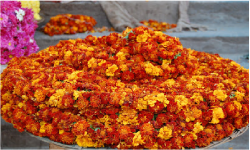 Flowers
Flowers
Flowers are offered to Maa Durga in the form of garlands to ornate Her
or as handful of petals or whole flowers or even bouquets, all as per the devotees
choice. Devotees may even choose artificial flower garlands to offer as well.
The beauty, the colour, softness, fragrance of flowers is bound to please anyone, even Gods.
With the offerings of flowers we pray that as She has given us these beautiful, colorful
flowers in so much abundance, may our hearts be full of abundant love for Her.
 Flowers
Flowers
Flowers are offered to Maa Durga in the form of garlands to ornate Her
or as handful of petals or whole flowers or even bouquets, all as per the devotees
choice. Devotees may even choose artificial flower garlands to offer as well.
The beauty, the colour, softness, fragrance of flowers is bound to please anyone, even Gods.
With the offerings of flowers we pray that as She has given us these beautiful, colorful
flowers in so much abundance, may our hearts be full of abundant love for Her.
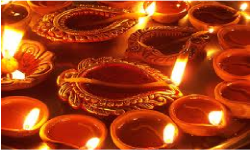 Candles and Diyas
Candles and Diyas
Lighting of a diya represents the connection of one's
soul to the Supreme Lord. As the diya emits light when the cotton wick burns, dipped
in ghee or oil, in the same way, we get lifted towards enlightenment when the wicks of our
souls burn out the oils of anger, hatred, lust, greed etc.
The shining flame removes darkness by illuminating the path of wisdom. The flame is considered another
form of Maa Durga, the fire element of the Universe, without which the world would
not survive. Maa Durga manifests in the form of flames at
Jwalamukhi Devi Temple situated about 35km North-East of Chintpurni Devi temple.
Light is the remedy for darkness, hence, we all should become givers of light.
Offering of light to the deities in any form, we become endued with beauty, energy, and resplendence.
Lighted diyas are used while performing Aarti.
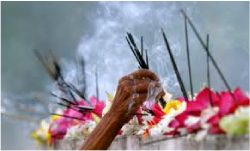 Dhoop and Agarbatti
Dhoop and Agarbatti
Lighting of the incense sticks as offerings, signfy
our complete submission to the Lord.
Dhoops and incenses are made of inflammable substances, in such a way that they may burn slowly or smoulder silently.
They are the inseparable accompaniments of a worship of the deities. As the stick burns and spreads fragrance all
around, may we also burn out our vices and spread the Lord's love and purity.
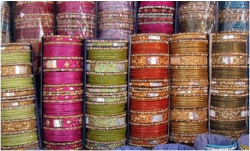 Bangles
Bangles
Bangles are a dear ornament for almost every Indian women. Glass
bangles, especially in Red, are said to be very dear to Maa Durga. Devotees may
offer bangles in various other colors or materials as well. During the Navratri
puja, bangles are also offered to small girls, who are considered to be Maa Durga's
souls.
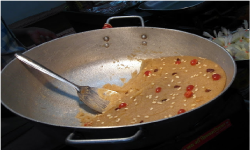 Halwa
Halwa
This is a sweet preparation made using Suji (Semolina), Ghee, Sugar
and optionally, dry friuts. The Halwa is the Prasad being offered to Maa. After
offering some of the quantity to Maa, the rest is returned by the priest to the
devotee.
How to make Suji (Semolina) Halwa:
Ingredients: 1 Cup Suji (Semolina/Rawa), 1/2 Cup ghee, 1 Cup water, 1/2 Cup sugar (adjust as per taste),
Optionally, Some coarsely chopped almonds and cashews ans few raisins.
Method: •Heat a pan on a medium heat and when hot add the ghee. When ghee melts, add the Sooji and mix well.
•Roast the Sooji till it begins to turn light golden color and give off a light aroma. Remember to stirring frequently.
•When the Sooji is roasted, carefully add the water, safely as it might splutter. Add sugar. Cook the mixture till it is thick and begins to come away from the sides of the pan.
Now add the almonds, cashews and raisins (if you are adding them) to the Sooji and mix well.
•Turn off the heat and allow the mixture to cool to a little.
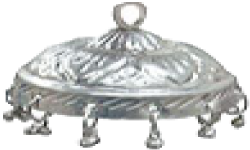 Chattar
Chattar
Chattar is an umbrella shaped ornament made of metal, and hung
above the idol or photo frame of Maa. This is offered in honour of Maa. Usually
the miniature forms of chattars are available for all. Devotees may buy bigger or
more ornate chattars made of silver or even gold.
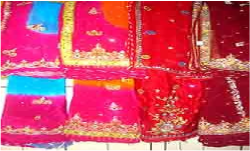 Chunri
Chunri
Also called, Chunni or Odhni, Chunri is the most dear attire for
Maa, especially in red colour and decorated in golden. Chunris are available for
purchase at bheint shops or devotees may choose to make one with their own hands.
Red and golden threads, mirrors, beads, sequins etc are used to decorate the chunri.
 Fruits and DryFruits
Fruits and DryFruits
Fresh friuts, available as per the season, or dry
fruits (chashews, almonds, walnuts, raisins etc) could be offered.
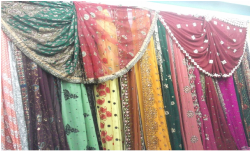 Cholas or Sarees
Cholas or Sarees
Devotees may also choose to offer dresses or sarees to Maa.
These can be used to ornate Maa Durga's idols in the temple.
 Nariyal
Nariyal
Coconuts are commonly used in most of the Hindu rituals.
Dhyanu Bhagat, an ardent devotee of Devi Maa spread Her name all around.
Dhyanu Bhagat was passing through Delhi with a group of pilgrims on their way to Mata Jwala Ji.
The then Mughal Emperor Akbar summoned him to his court to enquire about the Goddess.
Dhyanu Bhagat told him She is all powerful and answers the prayers of Her devotees.
To test Her power and Dhyanu’s faith, Akbar cut off the head of Dhyanu's horse.
He ordered Dhyanu that if his Goddess is so powerful, ask Her to put the horse’s head back.
Dhyanu continued his journey to Jwalaji and prayed day and night to no avail.
Out of desperation he cut off his own head and offered it to Devi Maa.
She then appeared to him, riding a lion. She reconnected both his head and that of the horse.
Devi Maa offered Dhyanu Bhagat a boon. He requested that it should not be so difficult for devotees to show their
devotion towards Her. Mata said that in the future if someone offered a coconut She would accept it as if they had
offered their own head. To this day people continue to offer coconuts to the Goddess in Her temples all over the world.
Read more about Maa Jwala Ji at website
www.JaiMaaJwalaJi.org
 Dhwaja
Dhwaja
Devotess may carry a red flag called Dhwaja to offer in honour of Maa Chintpurni Ji.
These are red colored flags, usually triangular and decorated in golden, fixed on a wooden or metal stick.
Images of Durga Maa are depicted on them along with praises for Her like 'Jai Mata Di'.
Other depictions on them could be symbol like 'Trishul', 'Om' - ॐ, Sun, Swatika, or Lotus
also these could be any of the dieties like Lord Ganesha or Lord Hanuman.
Flags can be seen hoisting on the apex of most of the Hindu temples. The depictions on the flags relate to the diety to who the temple is dedicated.
Flags symbolise the highest regard, the red colour and golden decorations derive the glow and power as that of the sun.
 Shringar
Shringar
Shringar includes makeup items like, nail paint, lip color,
kajal, bindi, kumkum, hair comb etc also including a mirror.
Bangles could be part of the shringar or taken separately.